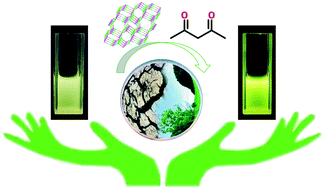A fluorescence red-shift and turn-on sensor for acetylacetone derived from ZnII-based metal–organic framework with new topology†
Abstract
A three-dimensional metal–organic framework, namely {[Zn3(BIBT)(BTC)5/3(μ3-OH)]·solvents}n (JXUST-4), has been synthesized by using ZnII ions, and BIBT and H3BTC ligands (BIBT = 4,7-bi(1H-imidazol-1-yl)benzo-[2,1,3]thiadiazole and H3BTC = 1,3,5-benzenetricarboxylic acid). JXUST-4 shows a new (3,3,7)-connected topology net containing a trinuclear ZnII cluster, uncoordinated N atoms of BIBT and uncoordinated carboxylate O atoms of H3BTC, which facilitates the interaction between the framework and analytes. Fluorescence studies indicate that JXUST-4 generates light yellow luminescence, which could be ascribed to ligand-centered emission. More importantly, JXUST-4 could be viewed as an effective fluorescent sensor toward acetylacetone through an obvious fluorescence red-shift with high sensitivity, efficient selectivity, and outstanding recycling capacity. Furthermore, the possible sensing mechanism of JXUST-4 toward acetylacetone is due to electron transfer and weak interactions between the analyte and framework.

- This article is part of the themed collection: Coordination Networks


 Please wait while we load your content...
Please wait while we load your content...